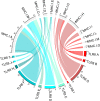Red Queen revisited: Immune gene diversity and parasite load in the asexual Poecilia formosa versus its sexual host species P. mexicana
- PMID: 31269085
- PMCID: PMC6608962
- DOI: 10.1371/journal.pone.0219000
Red Queen revisited: Immune gene diversity and parasite load in the asexual Poecilia formosa versus its sexual host species P. mexicana
Abstract
In accordance with the Red Queen hypothesis, the lower genotypic diversity in clonally reproducing species should make them easier targets for pathogen infection, especially when closely related sexually reproducing species occur in close proximity. We analyzed two populations of clonal P. formosa and their sexual parental species P. mexicana by correlating individual parasite infection with overall and immune genotype. Our study revealed lower levels of overall genotypic diversity and marginally fewer MHC class I alleles in P. formosa individuals compared to sexually reproducing P. mexicana. Parasite load, however, differed only between field sites but not between species. We hypothesize that this might be due to slightly higher genotypic diversity in P. formosa at the innate immune system (toll like receptor 8) which is likely due to the species' hybrid origin. In consequence, it appears that clonal individuals do not necessarily suffer a disadvantage compared to sexual individuals when fighting parasite infection.
Conflict of interest statement
The authors have declared that no competing interests exist.
Figures




Similar articles
-
Parasites in sexual and asexual mollies (Poecilia, Poeciliidae, Teleostei): a case for the Red Queen?Biol Lett. 2005 Jun 22;1(2):166-8. doi: 10.1098/rsbl.2005.0305. Biol Lett. 2005. PMID: 17148156 Free PMC article.
-
Peering through the looking glass at a sexual parasite: are Amazon mollies red queens?Evolution. 2003 Jun;57(6):1387-96. doi: 10.1111/j.0014-3820.2003.tb00346.x. Evolution. 2003. PMID: 12894946
-
Major histocompatibility complex variability in the clonal Amazon molly, Poecilia formosa: is copy number less important than genotype?Mol Ecol. 2009 Mar;18(6):1124-36. doi: 10.1111/j.1365-294X.2009.04097.x. Epub 2008 Feb 17. Mol Ecol. 2009. PMID: 19226318
-
Monophyletic origin of multiple clonal lineages in an asexual fish (Poecilia formosa).Mol Ecol. 2010 Dec;19(23):5204-15. doi: 10.1111/j.1365-294X.2010.04869.x. Epub 2010 Oct 21. Mol Ecol. 2010. PMID: 20964758
-
A review of Red Queen models for the persistence of obligate sexual reproduction.J Hered. 2010 Mar-Apr;101 Suppl 1:S13-20. doi: 10.1093/jhered/esq010. J Hered. 2010. PMID: 20421322 Review.
Cited by
-
Characterization, Selection, and Trans-Species Polymorphism in the MHC Class II of Heermann's Gull (Charadriiformes).Genes (Basel). 2022 May 20;13(5):917. doi: 10.3390/genes13050917. Genes (Basel). 2022. PMID: 35627302 Free PMC article.
-
Genetic slippage after sex maintains diversity for parasite resistance in a natural host population.Sci Adv. 2022 Nov 16;8(46):eabn0051. doi: 10.1126/sciadv.abn0051. Epub 2022 Nov 18. Sci Adv. 2022. PMID: 36399570 Free PMC article.
-
The characterization of toll-like receptor repertoire in Pinna nobilis after mass mortality events suggests adaptive introgression.Ecol Evol. 2023 Aug 4;13(8):e10383. doi: 10.1002/ece3.10383. eCollection 2023 Aug. Ecol Evol. 2023. PMID: 37546570 Free PMC article.
References
-
- Bell G. The masterpiece of nature: the evolution and genetics of sexuality. Berkeley, CA: University of California Press; 1982.
-
- Maynard Smith J. The evolution of sex. Cambridge: Cambridge University Press; 1978.
-
- Ridley M. Evolution. Oxford: Blackwell; 2004.
Publication types
MeSH terms
Substances
LinkOut - more resources
Full Text Sources
Research Materials

